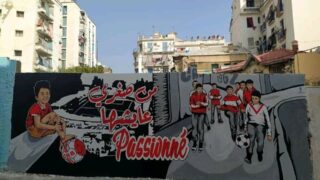
This publication has benefited from the support of the Rosa Luxemburg Foundation. This text may be reproduced in part or in full, provided the source is acknowledged.
In the last years, the Algerian press has not been mentioning “border burning” much, after having capitalized on it at the end of the first decade of the 21st century. This change in attitude has more to do with a trivialization of the phenomenon than its disappearance. Irregular migration, from the Algerian shores of the Mediterranean Sea, has become a structural practice in a society where the majority of the population has a “desire to leave” (1).
After the stabilization of the pattern of migration, or even after the period of recedingnumbers in the first half of the 2010s, the number of border burning attempts increased again during the year 2017. 5000 persons were arrested trying to embark, compared to around 1500 in 2015, according to the numbers of the Ministry of National Defense (2). These departures head to Spain. Between the 26thof October and the 3rd of November, around 600 Algerians had reached the Iberian coast (3) - and Italy which has witnessed a rebound in irregular maritime arrivals of Algerians in the middle of the 2000s (with around 1500 arrivals each year).
Algeria is traditionally a county of emigration transformed by transitions in the migrants’ movements into a country that receives immigrants from the sub-Saharan region and the unstable areas of the Middle-East.
In 2017, the United National High Commissioner for Refugees (UNHCR) says that the European coasts have witnessed the arrival of more than 8500 irregular Algerians. Though, these numbers should be put in perspective in comparison with the amount of the migrants coming from the sub-Saharan region, the Middle East or Central Asia, or even with the Moroccan migrations.
Algeria is traditionally a county of emigration transformed by transitions in the migrants’ movements into a country that receives immigrants from the sub-Saharan region and the unstable areas of the Middle-East. The Algerian emigration that began during World War I and increased during the “Roaring Twenties” (1920 – 1930) became massive in the period after World War II, when there was a need for workers to rebuild,and also later with the application of the right of family reunification in 1974 in France (4). An Algerian community abroad (5) was thus created, described by Algerian sociologist Abdelmalek Sayyad (6) as the “third generation” of Algerian emigration. Obtaining study or stay visas to the Schengen area became increasingly difficult with the progressionof irregular migration in the 90s and 2000s, as the conditions of entry and residence in Europe grew tighter.
In recent years, the Algerian press has not been mentioning “border burning” much, after having capitalized on it at the end of the first decade of the 21st century. This change in attitude has more to do with a trivialization of the phenomenon than with its disappearance. Irregular migration, from the Algerian shores of the Mediterranean Sea, has become a structural practice in a society where the majority of the population has adesire to leave.
A “fourth generation” (7) came into existence during the “dark decade” of the 90s in Algeria, but it principally concerned the intellectual elite (professors, researchers, doctors, journalists, artists …) who were mostly French-speaking seculars running away from the rise of fundamentalism and political violence and seeking asylum.
Today, asylum seekers are still many but they usually use their applications for asylum as a strategic step (8) which allows them to protectthemselves fromdeportation during the allocation period (asylum being rarely obtained by Algerians). Sometimes, Algerians try to pretend being Middle Easterners fleeing the wars ravaging the region. In front of the “Europe Fortress” which tends to entrench itself, irregular exile is the remaining option for the Algerian “border burners”. According to the director of the French Police for Air, Borders and Foreigners (PAFE), around 10000 Algerians are arrested every year for illegal residency, especially after having exceeded the duration of their visa permits to stay clandestinely in France. The visa is sometimes fraudulently obtained against several thousand euros paid to subcontractors at the French Consulates (“real fake” visas).
Border Burning concerns all social categories but it remains dominated by young men (sometimes teenagers), from lower classes and without stable employment. But, we have also seen young graduates, middle class relatively well-off people, individuals in their sixties or seventies, handicapped people, pregnant women and mothers with their infants go.
The “Wilayats” (Provinces) of the West (Tlemcen, Oran, Mostaganem) and of the East (Skikda, Annaba, El Tarf) are the main departure points in the direction of the regions of Almeria and Murcia in Spain and the island of Sardinia in Italy. Another longer route that appeared in the year 2010, goes from the region of Dellys towards the Spanish island of Mallorca. Border burning, the departure from the Algerian coasts in direction of the European shores through a direct maritime route, appeared between 2005 and 2006. Irregular migration in the 90s and the early 2000s used to follow traditional routes, passing through Morocco, to a lesser extentthrough Libya and, in very rare cases, through Syria, Turkey and Greece. At this time, the most used technique was to hide inside a cargo ship, with or without complicity. This is why many young Algerians would scrutinize the port looking for information.
Border Burning concerns all social categories but it remains dominated by young men (sometimes teenagers), from lower classes and without stable employment. But, we have also seen young graduates, middle class relatively well-off people, individuals in their sixties or seventies, handicapped people, pregnant women and mothers with their infants go.
The used techniques change a lot depending on the type of the network that arranges it. Many departures are made in an rudimentary way, through “spontaneous” networks (9) , but there are also “professional” networks that can recruit candidates from the entire national territory as well as “transnational” networks which can recruit across borders; the latter doesn’t seem to be really implemented in Algeria even though a few Algerians are detained in neighboring countries of the Maghreb for having tried to reach Europe through Morocco or Libya.
The organized networks, with a high division of labor, more concerned with making profits than with the success of the journeys, have developed in parallel to the rooting of the border burning practice, but those require a higher financial investment – between 80000 and 150000 dinars. The work breaks down between “a driver” in charge of the material and food, “a lodger” who gathers candidates before departure, and “smugglers” at the head of the organization who manage the whole network, sometimes with the complicity of members of the security forces.
Though, even if this type of organizations still exists despite their successive dismantling, the traditional networks represent an important part of the border burning operations. Far from the social and political images presented by the dominant security-oriented discourses, those networks are constituted by, first and foremost, the coastal residents who practice (or have practiced) maritime professions and know a lot about navigation and its risks (10) . They represent groups of solidarity, defined by kinship ties or places of habitation, bringing together a few persons who put their resources in common to equip themselves (boat, engine, GPS) and to form, at the end, a crew of a dozen persons who won’t spend more than 30000 to 50000 dinars – they might even leave for free if there is an available place or if the person leaving is known and respected by the rest of the group or if he is in a very precarious situation. It is also, for the youngest ones, a kind of rite of passage, of defiance against a backdrop of social impasse (11) . This reconversion of those who know how to navigate can also be explained by the decline of the profitability of small-scale fishing activities, because of sea pollution or the concurrence of trawlers and their competitiveness (12).
Two elements differentiate those networks: the organized ones gather people who don’t know each other and rely on outside actors. They aim for profitability: this is how we can find twenty or thirty persons on an embarkation. In the traditional networks, crossing remains a main objective, the solidarity of the group is based on them knowing each other: in short, the migrants, rarely more than ten on a boat (generally 5), master entirely the migration process thanks to the socialization of their means. Finally, the surveillance and the action of the security forces feed the migrants’ self-sustained dynamic of perfecting the means of migration with increasingly more powerful yet lighter boats, but this also forces the migrants to take more risks when the traditional routes are too closely monitored.
The authorities have reacted by creating the offence of “clandestine emigration”punished by a sentence of 2 to 6 months of prison and a 20000 to 60000 dinars fine. The candidates to exile are rarely condemned to stiff jail terms, except in some cases of recidivism; though the networks of smugglers are sometimes sentenced with many years of imprisonment. To dissuade the border burners, the Algerian authorities have sometimes relied on religious institutions such as the High Islamic Council that issued many fatwas assimilating irregular migration with suicide.
For those who manage to cross, it is usually the European coast guards who intercept them in the territorial waters. They evaluate their physical states and place them in confinement centers. Then, they are often released with an obligation to leave the territory or are held until their expulsion when the legal and administrative procedures can be done quickly.
For anyone who cares to listen, the discourse of the border burners is undoubtedly political. Unemployment or, to be more precise, the absence of a stable and legal economic activity, the lack of housing, the poor infrastructures, the corruption, the contempt they receivefrom the elites, the high costs of living, the ineffectiveness of public policies… have set a context in which it is better to “be eaten by the fishes than by worms” … The term “hogra” (contempt) expresses the feeling of the border burners about their position in their win country. They refuse to turn to institutions they are opposed to in order to resolve their daily problems (13).
Egypt: Calm Shores and Agitated Depths
30-03-2020
Factors of emancipation from the frameworks of the traditional society (escaping a forced marriage, accepting an unwanted outside marriage pregnancy…) and of individual autonomy inside the family structure (to provide for oneself or to the family…) also explain the search for a form of freedom allowing self-realization. In the absence of an independent political field and with a “miserable life” at the margins of society, Farida Sweih explains “border burning” as an “exit” allowing to circumvent alternatives to a political commitment doomed to failure, the passive acceptation of deplorable conditionsor even the entry into loyalty channels or clientelism. Thus, border burning imposes itself as a form of passive contestation or an active expression of discontent and displeasure (14).
Irregular migration therefore constitutes an important challenge for the Algerian regime, inside the country where the families of border burners lost at sea have been mobilizing for years and outside the country where it portrays an image very different than the one that the official communication wishes to promote.
Though, migrations, whether they are trans-Saharan or trans-Mediterranean, also constitute a major component of the Euro-Mediterranean geopolitics. Even though Algeria originally refused to play the role of the “policeman of Europe”, the reversed trendsin its legislations between 2008 and 2009 and the persistence of trans-Saharan migrations make this role an important bargaining tool for the country’s external relations.
The content of this publication is the sole responsibility of Assafir Al-Arabi and Rosa Luxemburg Foundation cannot accept any liability for it.
Translated from Arabic by Fourate Chahal Rekaby
Published in Assafir Al-Arabi on 01/10/2018
1-Kamel Rarrbo, «Le désir de partir», Confluences Méditerranée, n°14, Printemps 1995, pp. 21-26.
2-Charlotte Bozonnet, Zahra Chenaoui, « L’émigration algérienne repart à la hausse », lemonde.fr, 6 décembre 2017.
3-Sonia Lyes, « Arrivées massives de harragas : l’Espagne hausse le ton face à l’Algérie », TSA, 20 novembre 2017.
4-Farida Souiah, « L’émigration algérienne », Questions internationales, n°81, septembre-octobre, 2016, pp. 52-55.
5-With around a million and a half person in France and hundreds of thousands present in various countries such as Spain, Canada, USA or Germany.
6-Abdelmalek Sayad, « Les trois ‘âges’ de l’émigration algérienne en France », Actes de la recherche en sciences sociales, vol. 15, 1977, pp. 59-79.
7-Myriam Hachimi Alaoui, Les Chemins de l’exil. Les Algériens exilés en France et au Canada depuis les années 1990, Paris, L’Harmattan, 2007.
8-In Greece, some pretend to be Syrian but it rarely works out for them; in Germany or France the subterfuge is more quickly exposed and even though the seekers are almost systematically rejected, they stay numerous: they were more than 2500 to seek asylum in France in 2017.
9-For a typology of migratory networks in the Maghreb, c.f. Mehdi Mabrouk, « Émigration clandestine en Tunisie: organisations et filières », Naqd, n°26-27, 2009, pp. 101-126.
10-Among the interviewed border burners, none of them ignores the potential risks (damages that lead them to wander at sea and exhaust their provisions, shipwreck followed by drowning, arrests…) nor the difficulties of an immigrant’s life in Europe.
11-Noureddine Khaled, « Adolescents harragas : risquer sa vie comme seule possibilité de réalisation de soi », Adolescence, Tome 31, n°3, 2013, pp. 699-709.
12-Salim Chena, « Sidi Salem et el harga », Hommes & migrations, n°1300, 2012, pp. 52-61.
13-Public youth employment or business starting aid agencies are sometimes sought for grants under the pretext of engaging in fishing activities but the acquired money is usually reinvested in projects of clandestine departures.
14-Farida Souiah, « Les harraga algériens », Migrations société, n°143, 2012, pp. 105-120.




